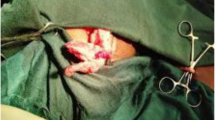Abstract
Purpose
Hydrocephalus is commonly associated with paediatric posterior fossa tumours and their resection. This is commonly managed by ventriculoperitoneal shunt insertion, which is associated with a lifelong risk of malfunction, necessitating revisional surgery. Few opportunities ever arise for the patient to be free of the shunt and this risk. We describe three patients shunted for tumour-related hydrocephalus who subsequently developed spontaneous shunt independence. We discuss this in the context of the literature.
Methods
A single-centre retrospective case series analysis was performed using a departmental database. Case notes were retrieved from a local electronic records database, and images were reviewed using national Picture Archiving and Communication Systems.
Results
Over a 10-year period, 28 patients underwent ventriculoperitoneal shunt insertion for tumour-related hydrocephalus. Of these, 3 patients (10.7%) went on to have their shunts successfully removed. Age at presentation varied from 1 to 16 years. In all cases, the patient required shunt externalization due to shunt or intra-abdominal infection. This was used as an opportunity to challenge the need for ongoing cerebrospinal fluid (CSF) diversion. In one case, this occurred only several months after a shunt blockage with intracranial pressure monitoring that proved her shunt dependence. All three patients tolerated this challenge, their shunt systems were removed without complication, and they remain free of hydrocephalus at last follow-up.
Conclusion
These cases reflect our poor understanding of the heterogenous physiology of patients with shunted hydrocephalus and underline the importance of challenging the need for CSF diversion at any appropriate opportunity.



Similar content being viewed by others
Availability of data and materials
Not applicable.
References
Bailey P, Mallucci (2019) Paediatric hydrocephalus. In: Kirollos RW, Helmy A, Thomson S, Hutchinson PJA (eds) Oxford Textbook of Neurological Surgery. Oxford University Press, Oxford, pp 1023–1036
Lam S, Reddy GD, Lin Y, Jea A (2015) Management of hydrocephalus in children with posterior fossa tumours. Surg Neurol Int 6(Suppl 11):S346–S348. https://doi.org/10.4103/2152-7806.161413
Prasad KSV, Ravi D, Pallikonda V, Raman BVS (2017) Clinicopathological study of pediatric posterior fossa tumors. J Pediatr Neurosci 12(3):245–250. https://doi.org/10.4103/jpn.JPN_113_16
Riva-Cambrin J, Detsky AS, Lamberti-Pasculli M, Sargent MA, Armstrong D, Moineddin R, Cochrane DD, Drake DM (2009) Predicting postresection hydrocephalus in pediatric patients with posterior fossa tumors. J Neurosurg Pediatr 3(5):378–385. https://doi.org/10.3171/2009.1.PEDS08298
Cabanes J, Vazquez R, Ribas A (1978) Hydrocephalus after posterior fossa operations. Surg Neurol 9(1):42–46 PMID: 304608
Bateman GA, Fiorentino M (2016) Childhood hydrocephalus secondary to posterior fossa tumor is both an intra- and extraaxial process. J Neurosurg Pediatr 18(1):21–28. https://doi.org/10.3171/2016.1.PEDS15676
Sherrod BA, Iyer RR, Kestle JRW (2020) Endoscopic third ventriculostomy for pediatric tumor-associated hydrocephalus. Neurosurg Focus 48(1):E5. https://doi.org/10.3171/2019.10.FOCUS19725
Paff M, Alexandru-Abrams D, Muhonen M, Loudon W (2018) Ventriculoperitoneal shunt complications: a review. Interdiscip Neurosurg 13:66–70. https://doi.org/10.1016/j.inat.2018.04.004
Hemmer R, Böhm B (1976) Once a shunt, always a shunt? Dev Med Child Neurol 37(suppl):69–73. https://doi.org/10.1111/j.1469-8749.1976.tb04282.x
Iannelli A, Rea G, Di Rocco C (2005) CSF shunt removal in children with hydrocephalus. Acta Neurochir (Wien) 147(5):503–507. https://doi.org/10.1007/s00701-005-0494-6
Rekate HL, Nulsen FE, Mack HL, Morrison G (1982) Establishing the diagnosis of shunt independence. In: Choux M (ed) Shunts and problems in shunts, symposium, Marseille, June 1980, vol 8. Frontiers Neurology Neuroscience. Basel, Karger, pp 223–226
Oi S, Di Rocco C (2006) Proposal of “evolution theory in cerebrospinal fluid dynamics” and minor pathway hydrocephalus in developing immature brain. Childs Nerv Syst 22(7):662–669. https://doi.org/10.1007/s00381-005-0020-4
Al-Holou WN, Sack JA, Garton HJL, Muraszko KM, Maher CO (2010) Removal of ventricular shunts. Pediatr Neurosurg 46:172–176. https://doi.org/10.1159/000321921
Iglesias S, Ros B, Ibáñez G, Delgado A, Ros A, Arráez MA (2019) Shunt independence in paediatric hydrocephalus: our 16-year experience and review. Childs Nerv Syst 35:1547–1555. https://doi.org/10.1007/s00381-019-04267-0
Lee KS, Chari A, Gillespie CS, Ekert JO, Saffari SE, James G, Aquilina K (2023) Endoscopic third ventriculostomy for shunt malfunction in the pediatric population: a systematic review, meta-analysis and meta-regression analysis. J Neurosurg Pediatr 1–10. https://doi.org/10.3171/2023.1.PEDS22427
Hersh D, Dave P, Weeks M, Hankinson T, Karimian B, Staulcup S, van Poppel M, Wait S, Vaughn B, Klimo P (2020) Converting pediatric patients and young adults from a shunt to a third ventriculostomy: a multicenter evaluation. Neurosurgery 87(2):285–293. https://doi.org/10.1093/neuros/nyz478
Lorber J (1981) Pucholt V (1981): When is a shunt no longer necessary? An investigation of 300 patients with hydrocephalus and myelomeningocele: 11–22 year follow up. Z Kinderchir 34:327–329. https://doi.org/10.1055/s-2008-1063369
Author information
Authors and Affiliations
Contributions
Conceptualisation: all. Data curation: all. Writing — original draft: GB, MDC. Writing — review and editing: MDC, AAW, EC. Visualization: MDC. Project administration: MDC. Supervision: MDC, AAW, EC.
Corresponding author
Ethics declarations
Ethical approval
This study was a retrospective and anonymised review of case notes and therefore an ethical review process was not sought.
Conflict of interest
The authors have no financial or non-financial interests to disclose.
Additional information
Publisher's Note
Springer Nature remains neutral with regard to jurisdictional claims in published maps and institutional affiliations.
Supplementary Information
Below is the link to the electronic supplementary material.
Rights and permissions
Springer Nature or its licensor (e.g. a society or other partner) holds exclusive rights to this article under a publishing agreement with the author(s) or other rightsholder(s); author self-archiving of the accepted manuscript version of this article is solely governed by the terms of such publishing agreement and applicable law.
About this article
Cite this article
Bankov, G., Cearns, M.D., Amato-Watkins, A. et al. Spontaneous shunt independence in paediatric tumour-related hydrocephalus: case series and review of the literature. Childs Nerv Syst 39, 3179–3184 (2023). https://doi.org/10.1007/s00381-023-05995-0
Received:
Accepted:
Published:
Issue Date:
DOI: https://doi.org/10.1007/s00381-023-05995-0




